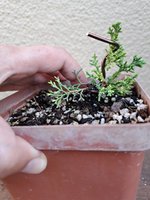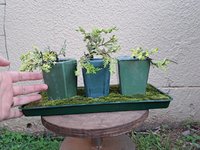Stella
Mame
I got some cuttings from a imported tree from our club mentor.
These are very special to me as this is not a variety we get here in SA, so propagating cuttings will be a big priority with these
This is the mother tree:

 www.willowbonsaishop.com
www.willowbonsaishop.com
Number one is about 3 years old and got some wiring done. Had this cutting for about 2 years and it's growing strongly.

This spring he gave me 4 more 1 year old cuttings
Number 2 I just got it higher in the pot and added some wiring creating tight bends.
Tried getting the bends as close as possible to the ground, so it's difficult to see the trunk in this pic.

Then our club was asked by the Japanese embassy to do the bonsai section in their cultural expo. And I was asked to do a demo and talk - the theme was bonsai for tiny spaces.
So Number 2-4 went to the demo and this is the start of my 1st composition.
Didn't want to do a forest so the idea is still to create the illusion of 1 tree in cascade style

We are info fall now, so wrong time for cuttings, but I did plant 6 very tiny shoots, and made myself a make shift greenhouse with a plastic toy box.
Our winters are very short and not to cold, so by any luck there may be one or 2 shoots that might root (Holding thumbs)
This will be my progression thread for all my projects related to these imported tree cutting
These are very special to me as this is not a variety we get here in SA, so propagating cuttings will be a big priority with these
This is the mother tree:

The Story of a Little Shimpaku, from Japan to South Africa
Japan has always been at the top of my bucket list of places to go since I started bonsai. I finally got the opportunity to go in 2017, when the Eighth World Bonsai Convention was held in Saitama, Japan. It was a dream come true to get on the plane and touch down on Japanese soil. My goal for...
 www.willowbonsaishop.com
www.willowbonsaishop.com
Number one is about 3 years old and got some wiring done. Had this cutting for about 2 years and it's growing strongly.

This spring he gave me 4 more 1 year old cuttings
Number 2 I just got it higher in the pot and added some wiring creating tight bends.
Tried getting the bends as close as possible to the ground, so it's difficult to see the trunk in this pic.

Then our club was asked by the Japanese embassy to do the bonsai section in their cultural expo. And I was asked to do a demo and talk - the theme was bonsai for tiny spaces.
So Number 2-4 went to the demo and this is the start of my 1st composition.
Didn't want to do a forest so the idea is still to create the illusion of 1 tree in cascade style

We are info fall now, so wrong time for cuttings, but I did plant 6 very tiny shoots, and made myself a make shift greenhouse with a plastic toy box.
Our winters are very short and not to cold, so by any luck there may be one or 2 shoots that might root (Holding thumbs)
This will be my progression thread for all my projects related to these imported tree cutting


